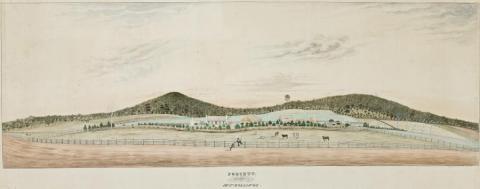'ROSY VANYAN', FORCETT. PROPERTY OF MR. JAS. ROLLINGS, 1855
CHARLES HENRY THEODORE COSTANTINI
watercolour on paper
36.5 x 105.5 cm
signed and dated lower right: C.H.T. Costantini Del’t Aug’st 1855.
titled lower centre: FORCETT.PROPERTY OF MR. JAS. ROLLINGS
James Rollings, Forcett, Tasmania
Thence by descent
Susanne Downey, Hobart
Masterpiece Fine Art Gallery, Hobart
Private collection, Launceston
C.H.T. Costantini: Island Exile, Allport Library and Museum of Fine Arts, Hobart, 1 August – 14 November 1997
Curnow, H., 'C.H.T. Costantini: Island Exile', The Australasian Antique Collector, 54th edition, December 1997 – June 1998, p. 86, illus. p. 85
In an age full of colour, Charles Henry Theodore Costantini was a very colourful character. Born in Paris of Italian descent, he was also known as Count T. Catalini, and by several other names. Being sentenced once (for forgery) to transportation for life to New South Wales in 1823 was not enough. In 1827 he received the very light sentence of seven years 'transportation for the theft of two notes to the value of £5 each. The reason he received an absolute pardon from Governor Brisbane in between the sentences was even more extraordinary. Visiting French explorer Hyacinthe de Bougainville pleaded successfully to Brisbane that Costantini's crime 'had been to force his attentions on a woman with 'too impetuous a passion'.1 Costantini left Sydney with de Bougainville as his ship's surgeon! His return visit was to Hobart Town in Van Diemen's Land. Continued troublesomeness led to being sent to the notorious secondary punishment station at Macquarie Harbour. It was here that he made studies of the settlement, examples of which, Macquarie Harbour and View of the Gates and Residence of the Pilot at Macquarie Harbour from the Bar c1828 are in the collection of the National Library of Australia, Canberra. Despite continuing troublesome behaviour, in March 1834 Costantini was given his freedom. Thereafter, art seemed to occupy his attention, and in the Launceston Cornwall Chronicle of 24 February 1838 he promoted his ability'to paint portraits in the most correct style, also views, and sketches of gentlemen's farms &c.'2
Noted as a portrait painter, there are a number of the Martin family of New Norfolk, of William Lee at Cressy, and those in the Sorrell area near Forcett dating from the 1850s.It was also the age of portraits of properties, of mansions and homesteads, the new settlers anxious to record the progress they were making in the Antipodes - for their own delectation or to send home to admiring relatives. Conrad Martens was busy in this genre in New South Wales, and later in Victoria, Thomas Clark and Eugène von Guerard painted many memorable canvases. Costantini's domestic landscapes, by comparison, are quite rare. The property of Mr James Jonathon Rollings (1819 - 1878) in our watercolour was located at Forcett, north east of Hobart, named 'Rosy Vanyan' after his property in Cornwall, England. Like his contemporaries, Rollings was a prosperous landholder, his property supporting wheat, sheep, cows, and fifteen children with his wife Martha Wiggins (1824 - 1894). Costantini's watercolour celebrates fruitfulness, the homestead nestled contentedly between the bosoms of anthropomorphically shaped hills. In the foreground Rollings and his dog admire his achievements, gazed upon by contented cows, all meticulously delineated and detailed with pride. A whimsical blend of naivety and humour gives this historical work its added attraction.
1. Stilwell, G.T., 'Costantini (Constantine, Constantini, Costantine), Charles Henry Theodore', in Kerr, J., The Dictionary of Australian Artists: Painters, Sketchers, Photographers and Engravers to 1870, Oxford University Press, Melbourne,1991, pp. 174-175
2. Quoted in Stilwell, op. cit., p. 175
DAVID THOMAS
